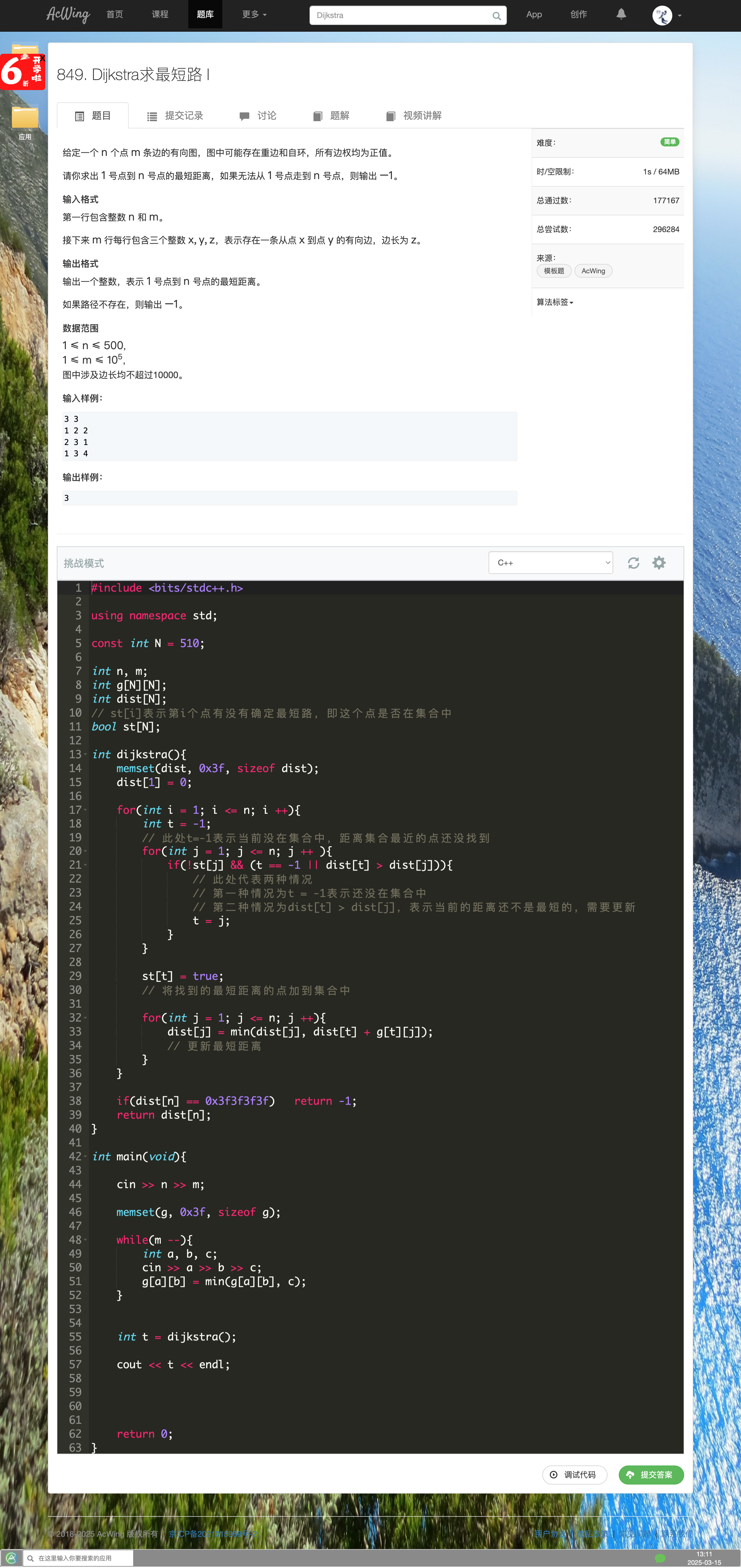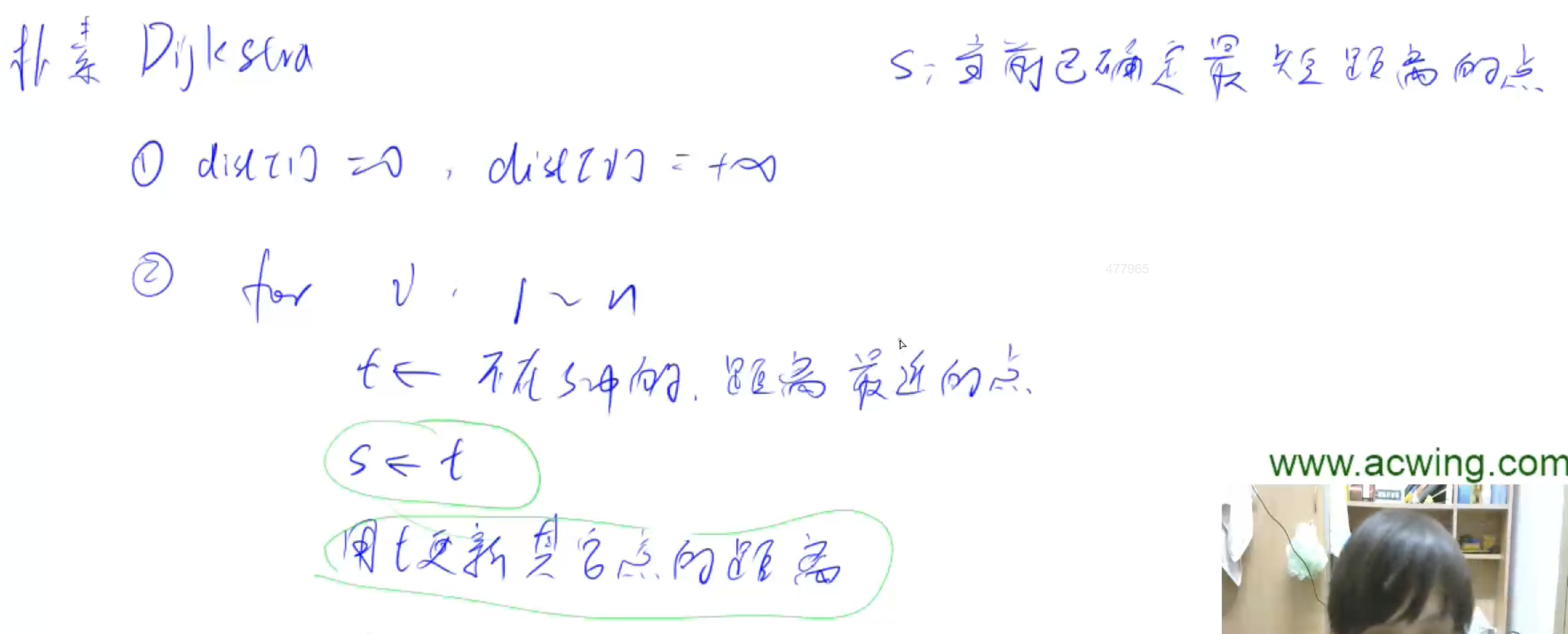搜索与图论
DFS
数字排列问题
#include <bits/stdc++.h>
using namespace std;
const int N = 10;
int n;
int path[N];
bool st[N];
void dfs(int u){
if(u == n){
for(int i = 0; i < u; i ++){
cout << path[i] << " ";
}
cout << endl;
return ;
}
for(int i = 1; i <= n; i ++){
if(!st[i]){
// 如果一个数没有被使用过
path[u] = i;
st[i] = true;
dfs(u + 1);
//恢复一个数的状态
st[i] = false;
}
}
}
int main(){
cin >> n;
dfs(0);
return 0;
}
n皇后问题

解题思路
- 和排列数字相同,只不过这次在一行数字中进行排列的是皇后所在的行号,例如:123表示
| Q | ||
|---|---|---|
| Q | ||
| Q |
- 注意剪枝
- 如果能过提前判断一个方案不合法,那么就提前中止递归
代码实现
第一种搜索顺序
- 对于同一列不能有多个皇后,我们设定数组
col[n]来记录每列中含有皇后的状态 - 对于对角线不能有多个皇后,我们设定数组
dg[n]来记录每个对角线中含有皇后的状态- 在使用时,我们利用一次函数截距为常量的性质,来保证每个正对角线中只含有一个皇后
- 例如:\(y = - x + b \rightarrow b = y + x\)\(y =x+b\rightarrow b = y -x\)由于$k >0$时可能导致数组下标为负,那么就需要添加一个足够大的常量保证其为正
- 对于反对角线不能有多个皇后,我们设定数组
udg[n]来记录每个反对角线中含有皇后的状态-
使用时为
udg[u - i + n]
-
#include <bits/stdc++.h>
using namespace std;
const int N = 20;
int n;
char g[N][N];
int col[N], dg[N], udg[N];
void dfs(int u){
if(u == n){
for(int i = 0; i < n; i ++){
cout << g[i] << endl;
}
cout << endl;
return ;
}
for(int i = 0; i < n; i ++){
if(!col[i] && !dg[i + u] && !udg[i - u + n]){
g[u][i] = 'Q';
col[i] = dg[i + u] = udg[i - u + n] = true;
dfs(u + 1);
g[u][i] = '.';
col[i] = dg[i + u] = udg[i - u + n] = false;
}
}
}
int main(){
cin >> n;
for(int i = 0; i < n; i ++){
for(int j = 0; j < n; j ++){
g[i][j] = '.';
}
}
dfs(0);
return 0;
}
第二种搜索顺序
#include <bits/stdc++.h>
using namespace std;
const int N = 20;
int n;
char g[N][N];
int row[N], col[N], dg[N], udg[N];
void dfs(int x, int y, int s){
if(y == n){
y = 0;
x ++;
}
if(x == n){
if(s == n){
for(int i = 0; i < n; i ++){
puts(g[i]);
}
cout << endl;
}
return ;
}
// 不放皇后
dfs(x, y + 1, s);
// 放皇后
if(!row[x] && !col[y] && !dg[x + y] && !udg[n + x - y]){
g[x][y] = 'Q';
row[x] = col[y] = dg[x + y] = udg[n + x - y] = true;
dfs(x, y + 1, s + 1);
g[x][y] = '.';
row[x] = col[y] = dg[x + y] = udg[n + x - y] = false;
}
}
int main(){
cin >> n;
for(int i = 0; i < n; i ++){
for(int j = 0; j < n; j ++){
g[i][j] = '.';
}
}
dfs(0, 0, 0);
return 0;
}
BFS
走迷宫
算法思路
- 利用
- 只有边权路都是1时,才可以用BFS求最短路
实现代码
#include <bits/stdc++.h>
using namespace std;
typedef pair<int, int> PII;
const int N = 110;
int n, m;
int g[N][N];
int d[N][N];
PII q[N * N];
int bfs(){
int hh = 0, tt = 0;
q[0] = {0, 0};
memset(d, -1, sizeof d);
d[0][0] = 0;
// 从迷宫的左上角出发
int dx[4] = {-1, 0, 1, 0};
int dy[4] = {0, -1, 0, 1};
// 横坐标和纵坐标分别向四个方向移动
while(hh <= tt){
auto t = q[hh ++];
for(int i = 0; i < 4; i ++){
int x = t.first + dx[i], y = t.second + dy[i];
if(x >= 0 && x < n && y >= 0 && y < m && g[x][y] == 0 && d[x][y] == -1){
d[x][y] = d[t.first][t.second] + 1;
q[ ++ tt] = {x, y};
}
}
}
return d[n - 1][m - 1];
}
int main(){
cin >> n >> m;
for(int i = 0; i < n; i ++){
for(int j = 0; j < m; j ++){
cin >> g[i][j];
}
}
cout << bfs() << endl;
return 0;
}
八数码
解题思路
- 求把数字变为正常顺序的最小步数
困难
- 三个问题需要解决:
- 状态表示复杂
- 如何记录每个状态的距离
- 可以将状态定义为一个字符串
记录状态
- 将每个状态定义为一个字符串
1 2 3
4 5 6
7 8 x
- 例如上面这个字符串就可以记录为
12345678x - 定义
queue<string> queue和unordered_map<string, int> dst用于求解
状态转移
- 记录状态转移过程总共分三步
- 首先把字符串恢复成
3*3的样子 - 移动,进行状态转移,枚举上下左右
- 将移动后的
3*3恢复成字符串
- 首先把字符串恢复成
解题代码
#include <bits/stdc++.h>
using namespace std;
int bfs(string start){
queue<string> q;
unordered_map<string, int> d;
q.push(start);
d[start] = 0;
int dx[4] = {-1, 0, 1, 0}, dy[4] = {0, -1, 0, 1};
string end = "12345678x";
while(q.size()){
auto t = q.front();
q.pop();
if(t == end)
return d[t];
int distance = d[t];
int k = t.find('x');
int x = k / 3, y = k % 3;
for(int i = 0; i < 4; i ++){
int a = x + dx[i], b = y + dy[i];
if(a >= 0 && a < 3 && b >= 0 && b < 3){
swap(t[k], t[a * 3 + b]);
if(!d.count(t)){
// 如果这种状态之前一次也没有出现过,那么就将其入队,并记录其距离
// Searches the container for elements whose key is _k_ and returns the number of elements found. Because [unordered_map](https://cplusplus.com/unordered_map) containers do not allow for duplicate keys, this means that the function actually returns 1 if an element with that key exists in the container, and zero otherwise.
d[t] = distance + 1;
q.push(t);
}
swap(t[k], t[a * 3 + b]);
}
}
}
return -1;
}
int main(){
string start;
for(int i = 0; i < 9; i ++){
char c;
cin >> c;
start += c;
}
cout << bfs(start) << endl;
return 0;
}
树与图的深度优先遍历
树和图的存储
- 由于树就是一种特殊的图,所以这里我们直接讨论图的存储方式
- 图分为:
- 有向图:$a \rightarrow b$
- 无向图:$a - b$
- 其实无向图可用$a \rightarrow b$和$b \rightarrow a$来表示
- 所以我们再次简化,只讨论有向图的存储方式:
- 邻接矩阵:开个二维数组
- 用
g[a][b]来表示$a\rightarrow b$ - 如果有权重$w$,那么
g[a][b] = w - 如果没有权重,那么
g[a][b] = 1,单纯存储一个bool值
- 用
- 邻接表:开$N$个单链表
- $N$个点,每个点对应一个单链表
- 每个单链表中存储的是与该点连接
- 邻接矩阵:开个二维数组

#include <bits/stdc++.h>
using namespace std;
const int N = 1e5 + 100, M = 2 * N;
int h[N], e[M], ne[M], idx;
void add(int a, int b){
e[idx] = b, ne[idx] = h[a], h[a] = idx ++;
}
int main(){
memset(h, -1, sizeof h);
}
树和图的深度优先搜索
#include <bits/stdc++.h>
using namespace std;
const int N = 1e5 + 100, M = 2 * N;
int n, m;
int h[N], e[M], ne[M], idx;
void dfs(int u){
st[u] = true;
for(int i = h[u]; i != -1; i = ne[i]){
int j = e[i];
if(!st[j])
dfs(j);
}
}
int main(){
int n;
cin >> n;
dfs(1);
return 0;
}
树的重心

知识点
解题思路
- 我们需要找到删去每个结点之后各个连通块中的点数的最大值
- 可以使用深度优先遍历去看每个点的子树的大小,然后使用总的点数减去子树大小,就可以获得另一连通块中点的数量
实现代码
#include <bits/stdc++.h>
using namespace std;
const int N = 1e5 + 100, M = 2 * N;
int h[N], e[M], ne[M], idx, n;
int ans = N;
bool st[N];
void add(int a, int b){
e[idx] = b, ne[idx] = h[a], h[a] = idx ++;
}
int dfs(int u){
st[u] = true;
// size是res,表示的是把这个点删掉之后,每一个连通块大小的最大值
// sum用来记录当前子树的大小
int size = 0, sum = 0;
for(int i = h[u]; i != -1; i = ne[i]){
int j = e[i];
if(st[j])
continue;
int s = dfs(j);
// 将这个点删除之后,这个点的每个子树都成为一个连通块了
size = max(size, s);
sum += s;
}
// 还要包含子树的头结点
size = max(size, n - sum - 1);
ans = min(ans, size);
return sum + 1;
}
int main(){
// int n;
cin >> n;
memset(h, -1, sizeof h);
for(int i = 0; i < n - 1; i ++){
int a, b;
scanf("%d%d", &a, &b);
add(a, b);
add(b, a);
}
dfs(1);
cout << ans << endl;
return 0;
}
树与图的广度优先遍历
图中点的层次
知识点
解题思路
- 第一个宽搜到的路径一定是最短的路径,直接返回就可以
- 使用队列存储每一层节点
实现代码
#include <bits/stdc++.h>
using namespace std;
const int N = 1e5 + 100;
int h[N], e[N], ne[N], idx;
// bool st[N];
int n, m;
int d[N];
void add(int a, int b){
e[idx] = b, ne[idx] = h[a], h[a] = idx ++;
}
int bfs(){
memset(d, -1, sizeof d);
queue<int> q;
d[1] = 0;
q.push(1);
while(q.size()){
int t = q.front();
q.pop();
for(int i = h[t]; i != -1; i = ne[i]){
int j = e[i];
if(d[j] == -1){
d[j] = d[t] + 1;
q.push(j);
}
}
}
return d[n];
}
int main(){
cin >> n >> m;
memset(h, -1, sizeof h);
for(int i = 0; i < m; i ++){
int a, b;
scanf("%d%d", &a, &b);
add(a, b);
}
cout << bfs() << endl;
return 0;
}

Dijkstra
Dijkstra求最短路1

算法思想
- 初始化距离,
dist[1] = 0, dist[i] = inf;初始化集合s,当前已确定最短距离的点 -
for i: 0 ~ ni从0~n进行迭代- 找到不在
s中,距离当前结构最近的点t - 把这个点
t加到s中 - 用t更新其他点的距离,即从a点到b点的路径中,由于t的加入,产生了新的路径,如果这个新的路径的距离更短,那么就要更新a点和b点之间最短路径的距离,其实就是判断
dist[x] > dist[t] + w
- 找到不在
- 稠密图用邻接矩阵存储
- 稀疏图用邻接表存储

实现代码
#include <bits/stdc++.h>
using namespace std;
const int N = 510;
int n, m;
int g[N][N];
int dist[N];
// st[i]表示第i个点有没有确定最短路,即这个点是否在集合中
bool st[N];
int dijkstra(){
memset(dist, 0x3f, sizeof dist);
dist[1] = 0;
for(int i = 1; i <= n; i ++){
int t = -1;
// 这个点t代表已经成图集合中距离原点最近的点,最开始赋值为-1表示还没有初始化没有找到
// 此处t=-1表示当前没在集合中,距离集合最近的点还没找到
for(int j = 1; j <= n; j ++ ){
if(!st[j] && (t == -1 || dist[t] > dist[j])){
// 此处代表两种情况
// 第一种情况为t = -1表示还没在集合中
// 第二种情况为dist[t] > dist[j],表示当前的距离还不是最短的,需要更新
t = j;
}
}
st[t] = true;
// 将找到的最短距离的点加到集合中
for(int j = 1; j <= n; j ++){
dist[j] = min(dist[j], dist[t] + g[t][j]);
// 更新最短距离
}
}
if(dist[n] == 0x3f3f3f3f) return -1;
return dist[n];
}
int main(void){
cin >> n >> m;
memset(g, 0x3f, sizeof g);
while(m --){
int a, b, c;
cin >> a >> b >> c;
g[a][b] = min(g[a][b], c);
}
int t = dijkstra();
cout << t << endl;
return 0;
}
Dijkstra求最短路2

知识点
解题思路
- 使用最小堆维护,可以在常数级别找到已经连通集合中距离散点集合最近的点
- 找到点后,判断该点是否已经被遍历过
- 如果遍历过则继续进行循环
- 如果没被遍历过则更新
dist[]数组
- 直至最小堆中没有任何元素
- 迭代
n - 1次,因为上来就选中了一个点
实现代码
#include <bits/stdc++.h>
using namespace std;
typedef pair<int, int> PII;
const int N = 1e6 + 100;
int h[N], w[N],e[N], ne[N], idx;
bool st[N];
int n, m;
int dist[N];
void add(int a, int b, int c){
e[idx] = b;
w[idx] = c;
ne[idx] = h[a];
h[a] = idx ++;
}
int dijkstra(){
memset(dist, 0x3f, sizeof dist);
dist[1] = 0;
priority_queue<PII, vector<PII>, greater<PII>> q;
// 优先队列中存储的是pair类型
// pair的首元素存储的是原点到该点的距离,因为需要小根堆根据距离进行排序
// pair的次元素存储的是该点的编号
q.push({0, 1});
while(q.size()){
auto t = q.top();
q.pop();
//
int ver = t.second;
int distance = t.first;
if(st[ver])
continue;
st[ver] = true;
for(int i = h[ver]; i != -1; i = ne[i]){
int j = e[i];
if(dist[j] > dist[ver] + w[i]){
dist[j] = dist[ver] + w[i];
q.push({dist[j], j});
}
}
}
if(dist[n] == 0x3f3f3f3f)
return -1;
return dist[n];
}
int main(){
cin >> n >> m;
memset(h, -1, sizeof h);
while(m --){
int a, b, c;
scanf("%d%d%d", &a, &b, &c);
add(a, b, c);
}
cout << dijkstra() << endl;
return 0;
}
bellman-ford
有边数限制的最短路

知识点
- 只要存在负权边,那么就不能使用Dijkstra算法
解题思路
- 循环
n次 - 在每次循环中,对于每条边
a, b, w,对距离进行更新\(\text{dist}[b]=\min (\text{dist}[b], \text{dist}[a]+w)\) - 对于实施BF算法后的
- 比如当前迭代了
k次- 从1号点经过不超过k条边,到了另一点的最短路径
- 如果迭代了n次,那么说明这条路径上有n条边,即这条路径上有
n + 1个点;给定一共有n个点,根据抽屉原理,则该条路径一定有两个相同点,即存在回路 - 所以,如果第n次迭代进行了更新,就说明存在一条边数为n的路径,就说明存在负环
实现代码
#include <bits/stdc++.h>
using namespace std;
const int N = 510, M = 10010;
struct Edge{
int a, b, w;
}edges[M];
int dist[N];
int last[N];
int n, m, k;
void bellmanford(){
memset(dist, 0x3f, sizeof dist);
dist[1] = 0;
for(int i = 0; i < k; i ++){
memcpy(last, dist, sizeof dist);
for(int j = 0; j < m; j ++){
auto e = edges[j];
dist[e.b] = min(dist[e.b], last[e.a] + e.w);
}
}
}
int main(){
cin >> n >> m >> k;
for(int i = 0; i < m; i ++){
// auto e = edges[i];
int a, b, w;
scanf("%d%d%d", &a, &b, &w);
edges[i] = {a, b, w};
}
bellmanford();
if(dist[n] > 0x3f3f3f3f / 2)
cout << "impossible" << endl;
else
cout << dist[n] << endl;
return 0;
}
spfa
spfa求最短路
知识点
解题思路
- 改进版的bellman-ford算法
- 对于更新的距离的端点,即使用到下列公式的点,将其入队\(\text{dist}[b]=\min (\text{dist}[b], \text{dist}[a]+w)\)
- 当队列不空时,进行遍历:
- 将队头出队,并赋值给
t - 更新
t的所有出边,对于更新的出边的另一端端点b,我们将其入队
- 将队头出队,并赋值给
实现代码
#include <bits/stdc++.h>
using namespace std;
const int N = 1e5 + 100;
int h[N], e[N], ne[N], w[N], idx;
int n, m;
int dist[N];
bool st[N];
void add(int a, int b, int c){
e[idx] = b, w[idx] = c, ne[idx] = h[a], h[a] = idx ++;
}
int spfa(){
memset(dist, 0x3f, sizeof dist);
dist[1] = 0;
queue<int> q;
q.push(1);
while(!q.empty()){
int t = q.front();
q.pop();
st[t] = false;
for(int i = h[t]; i != -1; i = ne[i]){
// i就是idx
int j = e[i];
if(dist[j] > dist[t] + w[i]){
dist[j] = dist[t] + w[i];
if(!st[j]){
q.push(j);
st[j] = true;
}
}
}
}
return dist[n];
}
int main(){
cin >> n >> m;
memset(h, -1, sizeof h);
while(m --){
int a, b, c;
scanf("%d%d%d", &a, &b, &c);
add(a, b, c);
}
int t = spfa();
if(t == 0x3f3f3f3f)
cout << "impossible" << endl;
else
cout << t << endl;
return 0;
}
spfa判断负环
知识点
解题思路
-
dist[x]最短距离 -
cnt[x]当前最短路的边数 - 更新方式
dist[x] = dist[t] + w[t];
cnt[x] = cnt[t] + 1;
实现代码
#include <bits/stdc++.h>
using namespace std;
const int N = 1e5 + 100;
int h[N], w[N], e[N], ne[N], idx;
int n, m;
int dist[N], cnt[N];
bool st[N];
void add(int a, int b, int c){
e[idx] = b, ne[idx] = h[a], w[idx] = c, h[a] = idx ++;
}
bool spfa(){
queue<int> q;
for(int i = 1; i <= n; i ++){
st[i] = true;
q.push(i);
}
while(!q.empty()){
int t = q.front();
q.pop();
// 如果这个点从队列中出队了
// 那么为了之后的遍历
// 需要将其访问状态设置为false
// 才能够让之后的结点访问
st[t] = false;
for(int i = h[t]; i != -1; i = ne[i]){
int j = e[i];
if(dist[j] > dist[t] + w[i]){
dist[j] = dist[t] + w[i];
cnt[j] = cnt[t] + 1;
if(cnt[j] >= n)
return true;
if(!st[j]){
q.push(j);
st[j] = true;
}
}
}
}
return false;
}
int main(){
cin >> n >> m;
memset(h, -1, sizeof h);
while(m --){
int a, b, c;
scanf("%d%d%d", &a, &b, &c);
add(a, b, c);
}
if(spfa())
cout << "Yes" << endl;
else
cout << "No" << endl;
return 0;
}
Floyd
Floyd求最短路

知识点
解题思路
- 使用动态规划解决这个问题,因为所有点都已经在图中
- 或许还需要深入理解……
实现代码
#include <bits/stdc++.h>
using namespace std;
const int N = 210, INF = 1e9;
int n, m, Q;
int d[N][N];
void floyd(){
for(int k = 1; k <= n; k ++){
for(int i = 1; i <= n; i ++){
for(int j = 1; j <= n; j ++){
d[i][j] = min(d[i][j], d[i][k] + d[k][j]);
}
}
}
}
int main(){
cin >> n >> m >> Q;
for(int i = 1; i <= n; i ++)
for(int j = 1; j <= n; j ++)
if(i == j)
d[i][j] = 0;
else
d[i][j] = INF;
while(m --){
int a, b, c;
scanf("%d%d%d", &a, &b, &c);
d[a][b] = min(d[a][b], c);
}
floyd();
while(Q --){
int a, b;
scanf("%d%d", &a, &b);
int t = d[a][b];
if(t > INF / 2)
cout << "impossible" << endl;
else
cout << t << endl;
}
}
Prim
Prim算法求最小生成树

知识点
解题思路
朴素Prim算法
- 首先将数组
dist[]初始化为$+\infty$ - 进行
n次迭代- 因为需要选取
n个点 - 找到集合外距离最近的点,并将其赋值给
t - 用
t更新其他点到集合的距离(与Dijkstra算法进行区分!)- 看一个生成树外的点有没有边连向集合内部的边,并找出最短的那条边
s[t] = true
- 因为需要选取
- 构成最小生成树的边就是每次点
t连接最小生成树的那条边,树有多条这种边构成的
实现代码
#include <bits/stdc++.h>
using namespace std;
const int N = 510, INF = 0x3f3f3f3f;
int g[N][N];
int n, m;
int dist[N];
bool st[N];
int prim(){
memset(dist, 0x3f, sizeof dist);
int res = 0;
for(int i = 0; i < n; i ++){
// 将i从0开始,可以自动初始化选择第一个点
// 如果从1开始,需要将数组dist[1]赋值为0
int t = -1;
for(int j = 1; j <= n; j ++){
if(!st[j] && (t == -1 || dist[t] > dist[j]))
t = j;
}
if(i && dist[t] == INF)
return INF;
if(i)
res += dist[t];
st[t] = true;
for(int j = 1; j <= n; j ++)
dist[j] = min(dist[j], g[t][j]);
}
return res;
}
int main(){
cin >> n >> m;
memset(g, 0x3f, sizeof g);
while(m --){
int a, b, c;
scanf("%d%d%d", &a, &b, &c);
g[a][b] = g[b][a] = min(g[a][b], c);
}
int t = prim();
if(t == INF)
cout << "impossible" << endl;
else
cout << t << endl;
return 0;
}
Kruskal
Kruskal算法求最小生成树
知识点
解题思路
- 将所有边按权重从小到大进行排序(算法瓶颈$\Omega(m\log m)$)
- 枚举每条边
ab,权重为c(类似于并查集,时间复杂度为$\Omega(m)$)- 如果
ab不联通,将ab这条边加入集合中 - 使用并查集来判断两个点之间有没有边,即两个点在不在同一集合当中
- 如果
实现代码
#include <bits/stdc++.h>
using namespace std;
const int N = 2e5 + 100, INF = 0x3f3f3f3f;
int p[N];
int n, m;
struct Edge{
int a, b, w;
bool operator< (const Edge &W) const{
return w < W.w;
}
}edge[N];
int find(int x){
if(p[x] != x)
p[x] = find(p[x]);
return p[x];
}
int kruskal(){
sort(edge, edge + m);
for(int i = 1; i <= n; i ++)
p[i] = i;
int res = 0, cnt = 0;
for(int i = 0; i < m; i ++){
int a = edge[i].a, b = edge[i].b, w = edge[i].w;
a = find(a), b = find(b);
if(a != b){
res += w;
cnt ++;
p[a] = b;
}
}
if(cnt < n - 1)
return INF;
return res;
}
int main(){
cin >> n >> m;
for(int i = 0; i < m; i ++){
int a, b, w;
scanf("%d%d%d", &a, &b, &w);
edge[i] = {a, b, w};
}
int t = kruskal();
if(t == INF)
cout << "impossible" << endl;
else
cout << t << endl;
return 0;
}
染色法判定二分图
染色法判定二分图

知识点
- 二分图当且仅当图中不含奇数环
- 充分性证明:由于图中不含奇数环,所以染色过程中一定没有矛盾
- 必要性证明:
- 可以把所有点划分到两边去
- 奇数环:环当中边的数量是奇数
解题思路
- 染色法
for(int i = 1; i <= n; i ++){
if i未染色
dfs(i);
}
实现代码
#include <bits/stdc++.h>
using namespace std;
const int N = 1e5 + 100, M = 2 * N;
int h[N], e[M], ne[M], idx;
int color[N];
int n, m;
bool dfs(int u, int c){
color[u] = c;
for(int i = h[u]; i != -1; i = ne[i]){
int j = e[i];
if(color[j] == 0){
if(!dfs(j, 3 - c))
return false;
}
else if(color[j] == c)
return false;
}
return true;
}
void add(int a, int b){
e[idx] = b, ne[idx] = h[a], h[a] = idx ++;
}
int main(){
cin >> n >> m;
memset(h, -1, sizeof h);
while(m --){
int a, b;
scanf("%d%d", &a, &b);
add(a, b);
add(b, a);
}
bool flag = true;
for(int i = 1; i <= n; i ++){
if(color[i] == 0){
if(!dfs(i, 1)){
flag = false;
break;
}
}
}
if(flag)
cout << "Yes" << endl;
else
cout << "No" << endl;
return 0;
}
匈牙利算法
二分图的最大匹配

知识点
解题思路

实现代码
#include <bits/stdc++.h>
using namespace std;
const int N = 510, M = 1e5 + 100;
int h[N], e[M], ne[M], idx;
bool st[N];
int match[N];
int n1, n2, m;
void add(int a, int b){
e[idx] = b, ne[idx] = h[a], h[a] = idx ++;
}
bool find(int x){
for(int i = h[x]; i != -1; i = ne[i]){
int j = e[i];
if(st[j] == false){
st[j] = true;
if(match[j] == 0 || find(match[j])){
match[j] = x;
return true;
}
}
}
return false;
}
int main(){
cin >> n1 >> n2 >> m;
memset(h, -1, sizeof h);
while(m --){
int a, b;
scanf("%d%d", &a, &b);
add(a, b);
}
int res = 0;
for(int i = 1; i <= n1; i ++){
// 需要将st数组设置为false,来让抢夺端点可行下去
// 如果一个人来抢夺端点,发现已经为true,那么将直接跳过
// 如果没有初始化为false
memset(st, false, sizeof st);
if(find(i))
res ++;
}
cout << res << endl;
return 0;
}
Enjoy Reading This Article?
Here are some more articles you might like to read next: